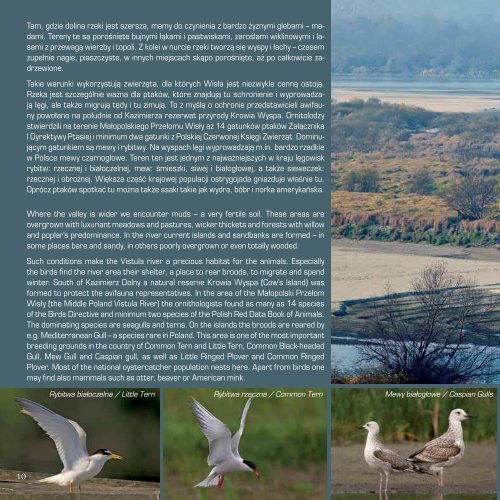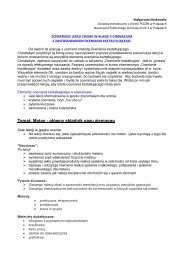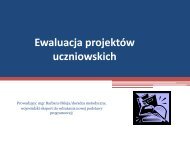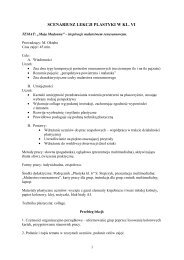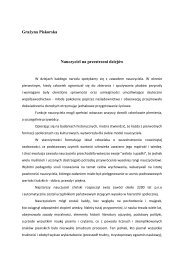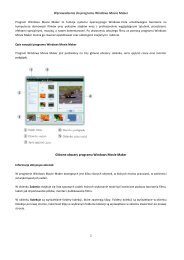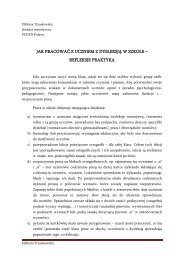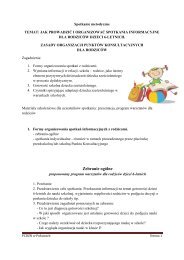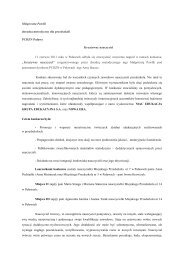Skarby przyrody Powiatu Puławskiego - Powiat Puławski
Skarby przyrody Powiatu Puławskiego - Powiat Puławski
Skarby przyrody Powiatu Puławskiego - Powiat Puławski
You also want an ePaper? Increase the reach of your titles
YUMPU automatically turns print PDFs into web optimized ePapers that Google loves.
Tam, gdzie dolina rzeki jest szersza, mamy do czynienia z bardzo żyznymi glebami – madami.<br />
Tereny te są porośnięte bujnymi łąkami i pastwiskami, zaroślami wiklinowymi i lasami<br />
z przewagą wierzby i topoli. Z kolei w nurcie rzeki tworzą się wyspy i łachy – czasem<br />
zupełnie nagie, piaszczyste, w innych miejscach skąpo porośnięte, aż po całkowicie zadrzewione.<br />
Takie warunki wykorzystują zwierzęta, dla których Wisła jest niezwykle cenną ostoją.<br />
Rzeka jest szczególnie ważna dla ptaków, które znajdują tu schronienie i wyprowadzają<br />
lęgi, ale także migrują tędy i tu zimują. To z myślą o ochronie przedstawicieli awifauny<br />
powołano na południe od Kazimierza rezerwat <strong>przyrody</strong> Krowia Wyspa. Ornitolodzy<br />
stwierdzili na terenie Małopolskiego Przełomu Wisły aż 14 gatunków ptaków Załącznika<br />
I Dyrektywy Ptasiej i minimum dwa gatunki z Polskiej Czerwonej Księgi Zwierząt. Dominującym<br />
gatunkiem są mewy i rybitwy. Na wyspach lęgi wyprowadzają m.in. bardzo rzadkie<br />
w Polsce mewy czarnogłowe. Teren ten jest jednym z najważniejszych w kraju lęgowisk<br />
rybitw: rzecznej i białoczelnej, mew: śmieszki, siwej i białogłowej, a także sieweczek:<br />
rzecznej i obrożnej. Większa część krajowej populacji ostrygojada gniazduje właśnie tu.<br />
Oprócz ptaków spotkać tu można także ssaki takie jak wydra, bóbr i norka amerykańska.<br />
Where the valley is wider we encounter muds – a very fertile soil. These areas are<br />
overgrown with luxuriant meadows and pastures, wicker thickets and forests with willow<br />
and poplar’s predominance. In the river current islands and sandbanks are formed – in<br />
some places bare and sandy, in others poorly overgrown or even totally wooded.<br />
Such conditions make the Vistula river a precious habitat for the animals. Especially<br />
the birds find the river area their shelter, a place to rear broods, to migrate and spend<br />
winter. South of Kazimierz Dolny a natural reserve Krowia Wyspa (Cow’s Island) was<br />
formed to protect the avifauna representatives. In the area of the Małopolski Przełom<br />
Wisły (the Middle Poland Vistula River) the ornithologists found as many as 14 species<br />
of the Birds Directive and minimum two species of the Polish Red Data Book of Animals.<br />
The dominating species are seagulls and terns. On the islands the broods are reared by<br />
e.g. Mediterranean Gull – a species rare in Poland. This area is one of the most important<br />
breeding grounds in the country of Common Tern and Little Tern, Common Black-headed<br />
Gull, Mew Gull and Caspian gull, as well as Little Ringed Plover and Common Ringed<br />
Plover. Most of the national oystercatcher population nests here. Apart from birds one<br />
may find also mammals such as otter, beaver or American mink.<br />
Rezerwat Krowia Wyspa / The Cow’s Island reserve<br />
Rybitwa białoczelna / Little Tern Rybitwa rzeczna / Common Tern Mewy białogłowe / Caspian Gulls Brodziec piskliwy / Common Sandpiper Czajka / Lapwing Rybitwy białoskrzydłe / White-winged Terns<br />
10 11


